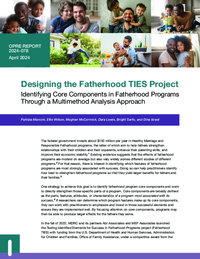Designing the Fatherhood TIES Project
Identifying Core Components in Fatherhood Programs Through a Multimethod Analysis Approach

Responsible Fatherhood programs funded through five-year grants from the Office of Family Assistance (OFA) deliver services to support parenting and father-child relationships, economic stability, and fathers’ relationships with romantic partners and coparents. Existing evidence suggests that the effects of fatherhood programs are modest on average but also vary widely. For that reason, there is interest in identifying which features of fatherhood programs are most strongly associated with success. Doing so can help practitioners identify how best to strengthen fatherhood programs so that they yield larger benefits for fathers and their families.
One strategy to achieve this goal is to identify fatherhood program core components and work to directly strengthen those specific parts of a program. Core components are broadly defined as the parts, features, attributes, or characteristics of a program most associated with its success. The Testing Identified Elements for Success in Fatherhood Programs project (Fatherhood TIES) aims to first identify core components in fatherhood programs and then rigorously test their impacts on outcomes related to fathers’ parenting, relationships with coparents, individual well-being, and economic stability.
If researchers can produce evidence about features that make up the core components of fatherhood programs, practitioners will have helpful information to emphasize and invest in those successful elements and ensure they are implemented well. By focusing attention on core components, programs may then be able to produce larger effects for the fathers they serve.
This brief describes the multimethod approach used to identify core components of fatherhood programs for rigorous testing.
- The benefits of a multimethod research design approach are twofold: it ensures a wide range of perspectives and types of information are incorporated into decisions about research priorities, and it improves rigor, reducing the risk of drawing inaccurate conclusions.
- Through this process, the study team identified the provision of individual support to fathers as being associated with larger effects on target outcomes. Interventions that provide individual support will therefore be made a priority in future stages of the TIES project.
Document Details
Mancini, Patrizia, Ellie Wilson, Meghan McCormick, Dara Lewis, Bright Sarfo, and Dina Israel. 2024. “Designing the Fatherhood TIES Project: Identifying Core Components in Fatherhood Programs Through a Multimethod Analysis Approach.” OPRE Report 2024-078. Washington, DC: Office of Planning, Research, and Evaluation, Administration for Children and Families, U.S. Department of Health and Human Services.






